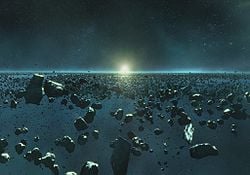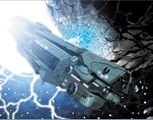Asteroid: Difference between revisions
From Halopedia, the Halo wiki
No edit summary |
m (→Gallery) |
||
| (32 intermediate revisions by 19 users not shown) | |||
| Line 1: | Line 1: | ||
{{ | {{Status|Canon}} | ||
{{Wikipedia}} | |||
[[File:Epsiloneridani.jpg|thumb|250px|One of [[Epsilon Eridani system|Epsilon Eridani]]'s two asteroid belts.]] | [[File:Epsiloneridani.jpg|thumb|250px|One of [[Epsilon Eridani system|Epsilon Eridani]]'s two asteroid belts.]] | ||
An '''asteroid''' is a naturally occurring solid object that is smaller than a planet. | An '''asteroid''' is a naturally occurring solid object that is smaller than a planet. They are often found in asteroid belts orbiting a star or in planetary ring systems. Asteroids may also occur scattered in orbital [[Lagrange point]]s.<ref>''[[Halo: The Cole Protocol]]'', page 166</ref> | ||
==Uses== | |||
Some asteroids have been converted by [[human]]ity to serve as [[human colonies|colony habitats]] or [[military base]]s. While many asteroids are too small to maintain sufficient gravitational pull or atmosphere on their outer surfaces despite advanced [[terraforming]] technology, this shortcoming can be surmounted by constructing the habitat into the hollowed-out interior of the asteroid, with [[artificial gravity|simulated gravity]] provided by the centrifugal force of the asteroid's spin. Notable examples of such asteroids were the [[Insurrectionist]] hideouts [[Eridanus Secundus]] and [[the Rubble]], the latter being a remarkable feat of engineering, composed of hundreds of asteroids with independent propulsion systems connected by flexible docking tubes.<ref>''Halo: The Cole Protocol'', page 62</ref> | |||
In a skirmish following the [[Callisto Incident]] in [[2494]], an asteroid was used by the | The [[Covenant]] used asteroids such as [[K7-49]] as refineries and shipyards.<ref name="GoO">''[[Halo: Ghosts of Onyx]]'', pages 83-84</ref> The [[Kig-Yar]] home system, the [[Y'Deio system]], is home to an exceedingly large asteroid field which is home to many Kig-Yar colonies.<ref>''[[Bestiarum]]''</ref> | ||
Asteroids have also seen weaponized uses in space engagements. In a skirmish following the [[Callisto Incident]] in [[2494]], an asteroid was used by the Insurrectionists to gain a tactical advantage in battle, using a outward-facing [[nuclear weapon|nuclear explosive device]] buried in an asteroid, greatly increasing the destructive power of the weapon in vacuum environment by providing enough reactive mass to destroy one UNSC ship and cripple two.<ref>''Halo: Evolutions'', The Impossible Life and the Possible Death of Preston J. Cole</ref> [[Forerunner]] warships, such as [[Harrier-class vessel]]s, were equipped with "gravity slings", gravitic weapons which allowed them to propel asteroids or other small objects at great velocities and use them as projectiles. A notable advantage of this over the more common [[directed energy weapon]]s was the vessel's ability to remain untraceable. This tactic was used by the Forerunners to their great advantage in the [[Battle of the 78th Thema|battle at Path Terrulian]] during the [[Forerunner-Flood war]].<ref>''Halo: Silentium'', String 25</ref> | |||
==Known asteroids or asteroid belts== | ==Known asteroids or asteroid belts== | ||
*[[Bonanza | *[[T'vao]] | ||
*[[Dal'koth]] | |||
*[[Ivanoff Station]] | |||
*[[Bonanza asteroid belt]] | |||
*[[Eridanus system|Eridanus asteroid belt]] | *[[Eridanus system|Eridanus asteroid belt]] | ||
**[[Eridanus Secundus]] | **[[Eridanus Secundus]] | ||
*[[Coral]] asteroid belt<ref>''[[Halo 3: ODST Pre-mission Evaluation]]'', Dutch Interview</ref> | |||
*[[Indra Asteroid Cluster]] | *[[Indra Asteroid Cluster]] | ||
*[[Origami Asteroid Field]] | *[[Origami Asteroid Field]] | ||
*[[The Rubble]] | *[[The Rubble]] | ||
*[[K7-49]] | *[[K7-49]] | ||
*[[Sothra Hakkor|Sothra Hakkor ring system]] | |||
*[[A'zhd]] | |||
==Trivia== | |||
The depictions of asteroid belts in ''[[Halo: Reach]]'' and ''[[Halo: Fall of Reach - Boot Camp]]'' follow a common popular culture depiction of an asteroid belt, where the asteroids float in an extremely dense field within visible distance of each other. In real life, asteroids are spaced millions of kilometers apart and it would be highly unlikely to even see one when passing through an asteroid field. | |||
==Gallery== | |||
<gallery> | |||
File:Reach-AsteroidField.jpg|An asteroid belt in ''Halo: Reach''. | |||
File:FoR Eridanus Secundus ext.png|Eridanus Secundus and the Eridanus asteroid belt. | |||
File:H2A Terminals TheRubble.png|A view of the Rubble. | |||
File:The Rubble.png|Another view of the Rubble. | |||
File:HE13 Infinity Impact.jpg|''Infinity'' collides with an asteroid. | |||
File:TFoR-as-Laden.jpg|The [[Parabola-class freighter|freighter]] ''[[Laden]]'' traversing through the [[Eridanus system]]'s asteroid belt. | |||
</gallery> | |||
==List of appearances== | |||
{{Col-begin}} | |||
{{Col-2}} | |||
*''[[Halo: The Fall of Reach]]'' {{1st}} | |||
*''[[Halo: First Strike]]'' | |||
*''[[Halo: Ghosts of Onyx]]'' | |||
*''[[Halo: Contact Harvest]]'' {{Mo}} | |||
*''[[Halo: The Cole Protocol]]'' | |||
*''[[Halo Wars: Genesis]]'' | |||
*''[[Halo: Evolutions - Essential Tales of the Halo Universe]]'' | |||
**''[[The Impossible Life and the Possible Death of Preston J. Cole]]'' | |||
*''[[Halo Legends]]'' | |||
**''[[The Babysitter]]'' | |||
*''[[Halo: Reach]]'' | |||
**''[[Dr. Halsey's personal journal]]'' {{Mo}} | |||
*''[[Halo: Fall of Reach]]'' | |||
**''[[Halo: Fall of Reach - Boot Camp|Boot Camp]]'' | |||
{{Col-2}} | |||
*''[[Halo 4]]'' | |||
*''[[Halo: Silentium]]'' | |||
*''[[Halo: Spartan Assault]]'' | |||
*''[[Halo: Initiation]]'' | |||
*''[[Halo: Escalation]]'' | |||
*''[[Halo: Mortal Dictata]]'' | |||
*''[[Halo: Broken Circle]]'' | |||
*''[[Halo 2: Anniversary]]'' | |||
**''[[Terminal (Halo 2: Anniversary)|Terminals]] | |||
*''[[Halo: Fleet Battles]]'' | |||
*''[[Halo: The Fall of Reach - The Animated Series]]'' | |||
*''[[Halo 5: Guardians]]'' | |||
*''[[Halo: Envoy]]'' | |||
*''[[Halo Infinite]]'' {{Mo}} | |||
*''[[Halo: The Television Series]] | |||
{{Col-end}} | |||
==Sources== | ==Sources== | ||
{{Ref/Sources}} | |||
[[Category:Asteroids]] | |||
[[Category:Asteroids| ]] | |||
[[Category:Astronomical objects]] | |||
Latest revision as of 23:33, March 21, 2022
| There is more information available on this subject at Asteroid on the English Wikipedia. |

An asteroid is a naturally occurring solid object that is smaller than a planet. They are often found in asteroid belts orbiting a star or in planetary ring systems. Asteroids may also occur scattered in orbital Lagrange points.[1]
Uses[edit]
Some asteroids have been converted by humanity to serve as colony habitats or military bases. While many asteroids are too small to maintain sufficient gravitational pull or atmosphere on their outer surfaces despite advanced terraforming technology, this shortcoming can be surmounted by constructing the habitat into the hollowed-out interior of the asteroid, with simulated gravity provided by the centrifugal force of the asteroid's spin. Notable examples of such asteroids were the Insurrectionist hideouts Eridanus Secundus and the Rubble, the latter being a remarkable feat of engineering, composed of hundreds of asteroids with independent propulsion systems connected by flexible docking tubes.[2]
The Covenant used asteroids such as K7-49 as refineries and shipyards.[3] The Kig-Yar home system, the Y'Deio system, is home to an exceedingly large asteroid field which is home to many Kig-Yar colonies.[4]
Asteroids have also seen weaponized uses in space engagements. In a skirmish following the Callisto Incident in 2494, an asteroid was used by the Insurrectionists to gain a tactical advantage in battle, using a outward-facing nuclear explosive device buried in an asteroid, greatly increasing the destructive power of the weapon in vacuum environment by providing enough reactive mass to destroy one UNSC ship and cripple two.[5] Forerunner warships, such as Harrier-class vessels, were equipped with "gravity slings", gravitic weapons which allowed them to propel asteroids or other small objects at great velocities and use them as projectiles. A notable advantage of this over the more common directed energy weapons was the vessel's ability to remain untraceable. This tactic was used by the Forerunners to their great advantage in the battle at Path Terrulian during the Forerunner-Flood war.[6]
Known asteroids or asteroid belts[edit]
- T'vao
- Dal'koth
- Ivanoff Station
- Bonanza asteroid belt
- Eridanus asteroid belt
- Coral asteroid belt[7]
- Indra Asteroid Cluster
- Origami Asteroid Field
- The Rubble
- K7-49
- Sothra Hakkor ring system
- A'zhd
Trivia[edit]
The depictions of asteroid belts in Halo: Reach and Halo: Fall of Reach - Boot Camp follow a common popular culture depiction of an asteroid belt, where the asteroids float in an extremely dense field within visible distance of each other. In real life, asteroids are spaced millions of kilometers apart and it would be highly unlikely to even see one when passing through an asteroid field.
Gallery[edit]
The freighter Laden traversing through the Eridanus system's asteroid belt.
List of appearances[edit]
|
Sources[edit]
- ^ Halo: The Cole Protocol, page 166
- ^ Halo: The Cole Protocol, page 62
- ^ Halo: Ghosts of Onyx, pages 83-84
- ^ Bestiarum
- ^ Halo: Evolutions, The Impossible Life and the Possible Death of Preston J. Cole
- ^ Halo: Silentium, String 25
- ^ Halo 3: ODST Pre-mission Evaluation, Dutch Interview





